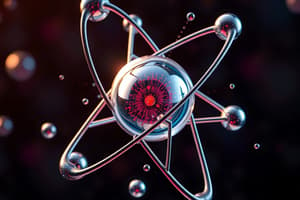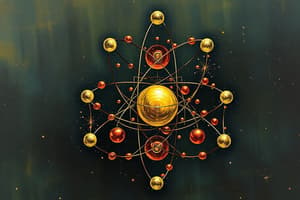Podcast
Questions and Answers
What are the 3 parts of an atom?
What are the 3 parts of an atom?
Protons, Neutrons, and Electrons
How are the 3 parts of an atom arranged?
How are the 3 parts of an atom arranged?
Protons and Neutrons are in the nucleus and electrons are formed around the nucleus
What is the atomic number for carbon?
What is the atomic number for carbon?
6
How many protons, neutrons, and electrons does carbon have?
How many protons, neutrons, and electrons does carbon have?
How many protons, neutrons, and electrons does Carbon-14 have?
How many protons, neutrons, and electrons does Carbon-14 have?
What is a chemical compound?
What is a chemical compound?
How does a covalent bond form?
How does a covalent bond form?
How does an ionic bond form?
How does an ionic bond form?
What is the difference between an ionic and covalent bond?
What is the difference between an ionic and covalent bond?
What is a Van der Waal force?
What is a Van der Waal force?
Why are water molecules polar?
Why are water molecules polar?
If sugar dissolves in water, what is the solute? What is the solvent?
If sugar dissolves in water, what is the solute? What is the solvent?
What is the pH range of a basic solution?
What is the pH range of a basic solution?
What is a valence electron?
What is a valence electron?
Why is carbon important to life?
Why is carbon important to life?
What are the monomers for the 4 macromolecules?
What are the monomers for the 4 macromolecules?
What are the four types of biological macromolecules?
What are the four types of biological macromolecules?
Name a structural carbohydrate.
Name a structural carbohydrate.
Name a storage carbohydrate.
Name a storage carbohydrate.
What is the difference between a peptide bond and a polypeptide?
What is the difference between a peptide bond and a polypeptide?
Name four functions of proteins.
Name four functions of proteins.
What are two characteristics of hydrophilic compounds?
What are two characteristics of hydrophilic compounds?
Would a hydrophilic compound be miscible with vegetable oil? Explain.
Would a hydrophilic compound be miscible with vegetable oil? Explain.
Name four important functions of lipids.
Name four important functions of lipids.
What are the parts of a fat molecule?
What are the parts of a fat molecule?
What are the two types of nucleic acids?
What are the two types of nucleic acids?
What are two functions of nucleic acids?
What are two functions of nucleic acids?
What are the steps to the scientific method (in order)?
What are the steps to the scientific method (in order)?
Flashcards are hidden until you start studying
Study Notes
Atom Structure
- Atoms consist of protons, neutrons, and electrons.
- Protons and neutrons are located in the nucleus; electrons are located in orbitals around the nucleus.
Carbon Atom Details
- Carbon has an atomic number of 6, indicating it has 6 protons, 6 electrons, and typically 6 neutrons.
- Isotope Carbon-14 has 6 protons, 6 electrons, and 8 neutrons.
Chemical Compounds
- Chemical compounds are substances made of two or more different elements that are chemically bonded together.
Bond Formation
- Covalent Bonds: Formed by the sharing of valence electrons between atoms, leading to stable molecule formation.
- Ionic Bonds: Occur when an atom loses an electron, resulting in a positive cation, while another atom gains the electron.
Bond Comparisons
- Covalent bonds involve sharing electrons; ionic bonds involve the transfer of electrons between atoms.
Intermolecular Forces
- Van der Waals Forces: Result from temporary distributions of electrons, causing slight positive and negative charge imbalances, leading to attractions and repulsions between molecules.
Water Molecule Polarity
- Water is polar due to its molecular shape, with one side having a negative charge and the opposite side having a positive charge.
Solution Components
- In a solution where sugar dissolves in water, sugar is the solute and water is the solvent.
Solution pH
- Basic solutions have a pH range of 8.5 to 14 and contain more hydroxide ions (OH-) than hydrogen ions (H+).
Valence Electrons
- Valence electrons are the electrons found in the outermost shell of an atom.
Importance of Carbon
- Carbon is critical for life as it forms complex molecules with elements like oxygen, hydrogen, and nitrogen, making it versatile due to its 4 available valence electrons.
Macromolecule Monomers
- Monomers of macromolecules include monosaccharides for carbohydrates, glycerol and fatty acids for lipids, nucleotides for nucleic acids, and amino acids for proteins.
Biological Macromolecules
- Carbohydrates: Composed of monosaccharides.
- Lipids: Made up of glycerol and fatty acids.
- Nucleic Acids: Consist of nucleotides.
- Proteins: Formed by amino acids.
Carbohydrates
- Structural Carbohydrates: Examples include cellulose and chitin.
- Storage Carbohydrates: Include starch and glycogen.
Peptide Bonds
- A peptide bond links two amino acids, while a polypeptide is a longer chain of multiple amino acids.
Protein Functions
- Proteins serve various roles: as antibodies to protect against viruses, messengers for signal transmission like hormones, enzymes for facilitating reactions, and transporters for substances.
Hydrophilic Compounds
- Characteristics include being soluble in water and typically consist of ionic or polar molecules.
Hydrophilic and Oil Interaction
- Hydrophilic compounds do not mix with vegetable oil since they dissolve in water but not in non-polar solutions like oil.
Lipid Functions
- Lipids store more energy than carbohydrates, consist of one glycerol and three fatty acids, provide insulation, and regulate temperature.
Fat Molecule Composition
- A fat molecule is structured from one glycerol and three fatty acids.
Nucleic Acids
- The two types of nucleic acids are DNA and RNA, critical for genetic information and protein synthesis.
Scientific Method Steps
- Steps include: making observations, formulating questions, hypothesis development, conducting controlled experiments, data analysis, conclusion drawing, and identifying sources of error.
Studying That Suits You
Use AI to generate personalized quizzes and flashcards to suit your learning preferences.




